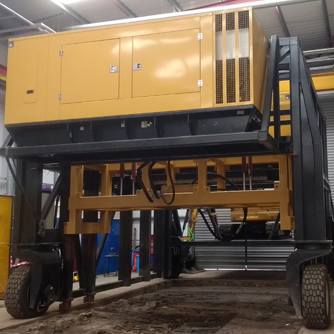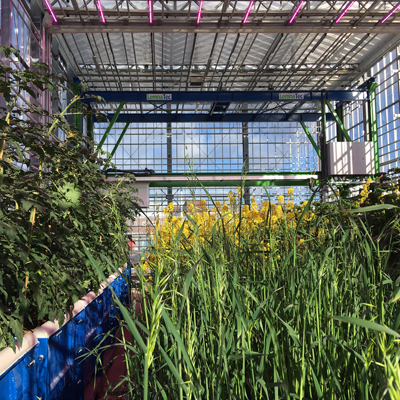The soil management facility provides a world-class resource for the detailed study of interactions between soil, crops/plants, water, agricultural machinery and off-road vehicles. The facility allows controlled simulation of agricultural and environmental systems at the soil aggregate to sub-field scale. The equipment can also be used for product performance testing (e.g. agrochemical fate and efficacy; effectiveness of erosion control technologies).
Key apparatus include:
The soil lane
The 45m long, 5m wide and 0.75 to 2m deep soil lane is designed to accommodate field-scale operations, such as cultivations and sowing, in a controlled and repeatable manner using the CHAP soil processor or commercial machinery.
Substrate (sand or soil) can be prepared in layers either in the lane or in the 1m3 CHAP soil containers to create a number of highly controlled and repeatable test profile conditions. The soil processor has instrumented mounting points for the testing of cultivation implements, tyres, tracks and sensors, and a variable drive system to allow for both low and high speed testing. The facility can also be used to determine the draught and vertical force requirements of soil-engaging implements that influence energy consumption and fuel costs.
The soil erosion laboratory
This facility includes pressurised and gravity-fed rainfall simulators that simulate temperate and tropical rainfall, with realistic drop sizes, intensities and kinetic energies, for a range of return period storm events. As well as undertaking fundamental research into soil erosion and hydrological processes at a sub-process level, the soil erosion laboratory is ideal for evaluating the erodibility of slope forming materials (including soil, waste-rock and ores). Performance testing of erosion control technologies, including geotextiles, filter socks and soil conditioners, is also possible.
Slope adjustable (0-45o) runoff rigs (up to 1.0m x 2.0m) and experimental erosion trays allow the collection of surface runoff and infiltration, eroded material and associated pollutants at a range of spatial scales.
Modular (up to 6.0m x 2.0m) and single post rainfall simulators are available for field-based runoff and soil erosion studies. Dedicated instrumentation is used to monitor runoff, erosion and meteorological data from large scale runoff /erosion field plots, both on site and remotely.
Supporting facilities
- A comprehensive range of instruments to measure soil mechanical, physical, biological and chemical properties.
- A laser optical disdrometer to measure raindrop size, velocity and energy.
- Field monitoring and surveying equipment.
- Photogrammetry and remote sensing equipment, including the AgriEPI phenotyping platform.
- The CHAP glasshouse and environmental growth rooms for the establishment and growth of vegetation.
- CHAP leaf area meter, drying ovens and root-washing facility for measurement of vegetation effects on hydrology and erosion.
- Single wheel tester for traffic loading studies.
Key benefits
- Highly controllable and repeatable experimental conditions.
- A range of substrates can be used in the soil lane and soil erosion laboratory.
- Field-scale testing of cultivation implements, tyres, tracks and sensors.
- Determination of draught and vertical force requirements, and tillage efficiency.
- Single wheel to whole vehicle testing.
- Accurate simulation of current and predicted rainfall events for hydrological and erosion process studies in the laboratory or field.
- Full performance testing of soil erosion control technologies.
- Validation of laboratory generated data with on-farm results.
- Controlled testing of imported soils, waste-rock and ores under Cranfield University’s soil import licence.
Summary of applications
- The facility’s experimental capability applies to all land-based industries: agricultural, civil and environmental engineering, land reclamation, land restoration and sports surface technology.
- Controllable and repeatable conditions generate sound scientific evidence for environmental model development and product testing.
- The research outcomes enable the development of more efficient and sustainable methods of food, fibre and fodder production, including more fuel efficient land-based technologies.
- Solutions to land-based challenges faced by the MOD, the utility sector and the aviation industry.
- Design of precision weeding mechanisms for inter and intra-row weed control.
- Development of ‘on-the-go’ sensor and system control technology, with predictive modelling of the soil-plant-water system.
- An assessment of the impact of modern agriculture processes on buried archaeology.
- Design, optimisation and performance benchmarking of soil engaging implements through measurements of draught force and soil disturbance in controlled conditions.
- Fundamental research into erosion processes and hydrological studies at a process and sub-process level.
- Comparative erodibility of slope forming materials (including soil, waste-rock and ores) to inform design and storm water runoff control measures during ‘Life of Mine’.
- Effect of rainfall intensity and soil surface sealing on seedling germination and emergence.
- Contamination of salad leaves by rainsplash soil detachment.
- Development of a wide range of soil and water conservation methods suitable for use in agriculture, horticulture, the construction industry, mine reclamation and land restoration.
- Testing of geotextile materials for the stabilisation of slopes and prevention of soil erosion.
- Pesticide fate and efficacy trials.
- Rural earth road testing (depth of rut deformation).






